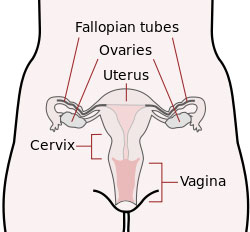What Is Ovarian Cancer?
Ovarian Cancer is the fifth leading cause of cancer related deaths among women of the ages 35-74. This form of cancer begins in the ovaries, which are the reproductive glands found in women on each side of the uterus in the pelvis. These glands are the main source for the female hormones estrogen and progesterone.

Most tumors are benign (or non-cancerous), never spread beyond the ovaries and can be treated by either removing the part of the ovary that contains the tumor, or removing the entire ovary. The type of tumors that aren’t benign, meaning they are malignant or low malignant potential tumors. These types of tumors can spread (metastasize) to other parts of the body and can be fatal to the patient.
The lack of effective screening methods typically means there is a poor survival rate with the discovery being made at advanced stages. Approximately only 20% of ovarian cancers are found at an early stage. It is of the utmost importance for women to talk with their doctor and know the warning signs of ovarian cancer. These include bloating or increased abdominal size, difficulty eating or feeling full quickly, frequent or urgent need to urinate and pelvic or abdominal pain. If any of these symptoms persist for more than two weeks see a physician immediately.
Recognizing and changing risk factors is also important.
- Belly fat can raise your risk of ovarian cancer.
- Being overweight or obese, 25 pounds or more have a much higher risk factor. (30% more compared to women who are at a healthy weight)
- Dairy products have been shown to increase the risk of ovarian cancer as well. The lactose, found in most dairy food, has been thought to promote cancer growth. One glass of milk or ice cream contains 30 grams of lactose. People who had 30 grams or more a day increased their ovarian cancer risk by 20%.
Ovarian Cancer Symptoms
As previously mentioned, here are some of the typical symptoms of Ovarian Cancer:
- bloating or increased abdominal size
- difficulty eating or feeling full quickly
- frequent or urgent need to urinate
- pelvic or abdominal pain
Ovarian Cancer Treatment Options
After a positive diagnosis has been made, your doctor or oncologist will recommend one or more treatment options. The main treatment options for ovarian cancer patients are surgery, chemotherapy, and radiation therapy. DCA (sodium dichloroacetate) is also an effective tool to fight ovarian cancer and can be taken along side any of the previously mentioned cancer treatments. DCA is not known to conflict with any other medication or cancer treatment option.
Ovarian Cancer Prevention
Losing weight through healthy diet and exercise can cut your risks dramatically. Activity 3-5 days a week of 30 minutes or more can also help. Any change of diet and exercise should be closely monitored and discussed with your physician.
Birth control pills have been shown to protect against ovarian cancer. Taking the pill for 15 years or more cut the risk by 58% according to one study. Even women taking the pill for 1-4 years lowered the risk by 22%. Also important is fiber, it is one of the best cancer fighting weapons in your arsenal. Research has found that soluble fiber which can be dissolved in water or insoluble which cannot be dissolved in water reduces the risk of cancer for women who consume more than 30 grams a day. A high fiber diet 38-77 grams a day can reduce the risk by more than 20% compared to those with low fiber intake. The production of sex hormones is lowered by fiber consumption.
Here is a short list of some fiber power houses to include in your diet, rye bread, bran flakes and wheat bread. These contain 5.2-5.6 grams. Some fruits that should make your list are prunes, pears, mangoes, apples, raspberries, blackberries and strawberries. Seedless raisins can help as well. Beans and lentils and many nuts will up your fiber intake. Try almonds, pistachios, peanuts, walnuts and pecans just to name a few. A few more to consider, pumpkin, whole wheat pasta, tomato paste, and broccoli can pack a punch.

Comments are closed.